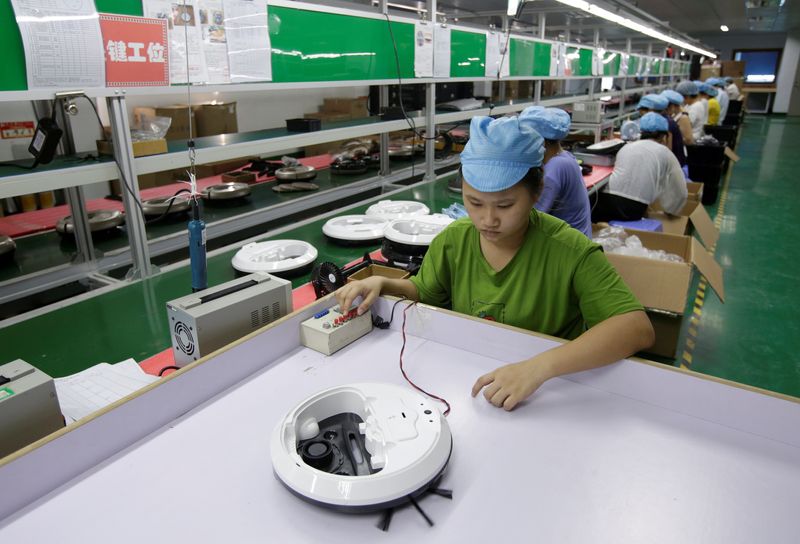
China Nov factory activity expands for second month as Trump threats loom
By Ziyi Tang and Joe Cash
BEIJING (Reuters) -China’s factory activity expanded modestly for a second straight month in November, an official survey showed, adding to a string of recent data suggesting a blitz of stimulus is finally trickling through the world’s second-largest economy just as Donald Trump ramps up his trade threats.
The National Bureau of Statistics purchasing managers’ index (PMI) on Saturday rose to 50.3 – a seven-month high – from 50.1 in October, above the 50-mark separating growth from contraction and beating a median forecast of 50.2 in a Reuters poll.
The mood in China’s manufacturing sector has been depressed for months due to tumbling producer prices and dwindling orders, but two months of positive PMI readings suggest the stimulus announcements are improving sentiment on factory floors.
That said, fresh headwinds from additional U.S. tariffs could threaten China’s industrial sector next year and pour cold water over any early optimism in the Asian giant’s manufacturing sector.
While there have been some signs that Chinese policymakers’ latest moves may be lending support to the ailing property market, which has weighed heavily on domestic demand, officials are now in a race to limit the economy’s vulnerabilities ahead of a second Trump presidency.
President-elect Trump said on Monday he would impose a 10% tariff on Chinese goods so that Beijing does more to stop the trafficking of Chinese-made chemicals used in the production of fentanyl.
He also threatened tariffs in excess of 60% on Chinese goods while he was on the campaign trail, hikes that pose a major growth risk for the world’s top exporter of goods.
China’s exports surged more than expected in October, which analysts attributed to factories rushing out shipments to major markets in anticipation of further tariffs from the U.S. and the European Union.
“The economy stabilized recently as fiscal and monetary policies eased after the Politburo meeting on September 26. But the outlook for 2025 remains unclear,” said Zhang Zhiwei, president and chief economist at Pinpoint Asset Management.
“The trade war is looming and it will delay investment decisions by the corporates. The investors expect fiscal stimulus but the size and composition of spending are uncertain,” said Zhang.
The central economic working conference in December may shed some light on the policy outlook, he added.
The PMI report showed total new orders expanded for the first time in seven months in November, while new export orders contracted for the seventh consecutive month.
INSUFFICIENT DEMAND
“The PMI index continued to rise in November, indicating more obvious signs of recovery at the bottom of the economy. The effect of policies in boosting business confidence is becoming stronger,” said Zhang Liqun, an analyst at the China Logistics Information Center.
However, “insufficient demand is still a major constraint on enterprise production activities,” said Zhang. “It is necessary especially to strengthen the effective driving of government public investment on enterprise orders.”
The non-manufacturing PMI, which includes construction and services, fell to 50.0 this month, after it rose to 50.2 in October. Activity in the services sector expanded modestly for a second month in a row.
Earlier this month, China unveiled a 10 trillion yuan ($1.38 trillion) debt package to ease municipal financing strains. That followed China’s central bank in September introducing its biggest stimulus since the pandemic to pull the economy back towards the governments growth target of around 5%.
Chinese policy advisers are recommending that Beijing should maintain that same growth target next year and introduce even more stimulus to bolster domestic demand.
There are early signs that the economy is turning a corner.
Retail sales, a gauge of consumption, grew the most since February last month, and a slump in property sales narrowed, possibly indicating that the beleaguered sector was limping back to life.
But industrial output last month slowed slightly from September’s pace and industrial profits, a lagging indicator, continued to fall, pointing to how difficult it is for firms to remain profitable in the current economic climate in China.
The private sector Caixin factory survey will be released on Monday and analysts expect its reading to edge up to 50.5.
China’s official November composite PMI, which includes both manufacturing and services activity, remained at 50.8 in November.

